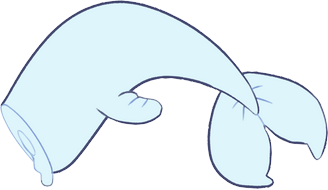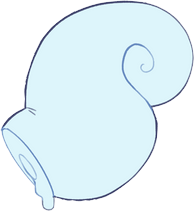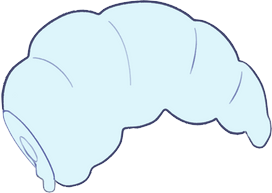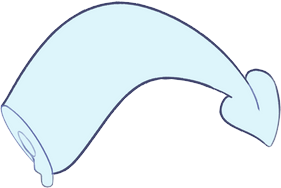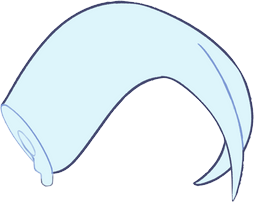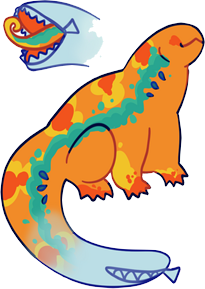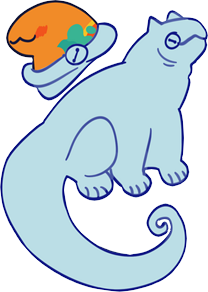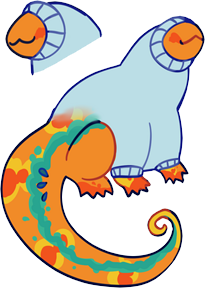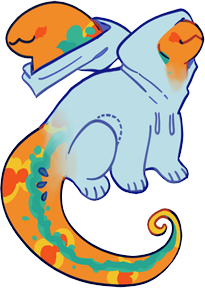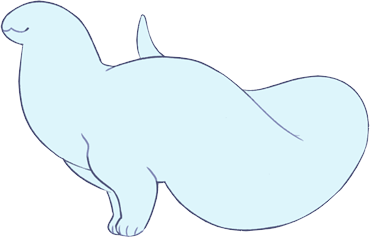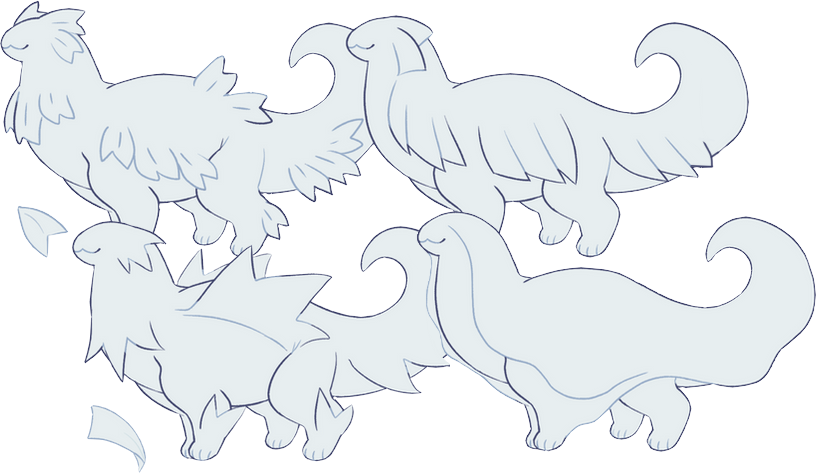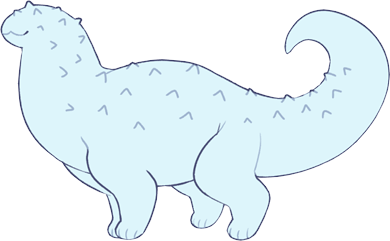Traits
Finned tail (Normal)
A basic tail with a simple short finned tip.
Seen as a more specialized tadpole tail, this is for leeches that spend most of their time/hunts in the water.
The fins have never been known to exceed regular feeler length on non-saltwater leeches.
Curled tail (Normal)
A larger basic tail, held in a tightly curled formation.
Younger leeches with this trait can uncurl their tail, but as they age the muscle development eventually holds it in this shape permanently.
Scorpion tail (Normal)
A bulky tail with a sharp stinger, but it doesn't pack venom.
These tails are flexible and dexterous, often seen on security-trained leeches for extra threat factor.
Note: Containing a toxin is classed as Unlisted Myth, and it can range from as minor as a bee sting, to venom that destroys tissue in seconds - but this is a very rare occurrence, and usually only seen in lab-restricted specimens.
Floppy tail (Normal)
A much larger basic tail, coiled upward off the ground.
Much like curled, leeches hold their tail like this to avoid collateral damage, but due to being a much looser shape there is no muscular degradation and it can always be uncurled at will.
Tentacle tail (Normal)
A long, flexible tail with suckers underneath it.
Leeches often use this handy trait to capture and hold prey, or reach high places and grab things their owner won’t give them.
Tanuki tail (Normal)
Broad and blunt-tipped, tanuki is a trait that's exhibited by grub tailed leeches that dropped their tail due to damage or to distract an attacking predator.
Ironically, it’s said that touching this tail will bring you money and fertility, despite its origins of misfortune.
Split end tail (Normal)
A tail that has split in two near the tip.
The split can only be near the end of the tail as not to be confused with the multiple tail Myth trait.
This tail can appear as a genetic mishap, or if the tail suffers damage as a tadpole is developing. Regardless, the two tips still move in unison as if they were still one tail.
Kigu hood (Normal)
A popular cross between two other variations, the Kigu is often considered 'Suit-lite' and features a baggy extra layer of skin over the leech's body combined with the comfortable open hood of the Sweat variation.
This makes the leech look floppy, adorable, and pajama party ready, making it a big hit with families and neighborhood petting zoos. Kigu leeches are often bred to look like other animals or popular mascots, and can fetch a high price depending on how cute and close to the original they can get! An unexpected side effect of breeding this variation, however, is the 'buttons' that often appear on the front of the Kigu - Nine times out of ten, they're actually the leech's eyes.
Pelt hoodie (Normal)
More of a disorder than a desirable hoodie variation, Pelts occur when the leech makes an attempt to shed its skin and loses the ability to slough it off part of the way through. While the limbs, tail, and certain edges of the pelt are loose and can flop around freely, the spine of the pelt is still firmly attached to the leech's back and cannot be removed.
More often than not the pelt will change to a different color or pattern from the leech's normal skin, and may sport the appearance of feelers and other traits, making it look like it belongs to a different creature. Opinions on Pelts vary, as some regard it as the product of a poorly raised leech, while others consider it 'Metal as F**k'
Note: It can sport head and body traits as long as they remain within the trait's limits; i.e horns that appear on the pelt's head count as the single allowed horn set without a myth upgrade.
The snout of the pelt must retain a standard leech mouth.
Tailmouth hoodie (Normal)
The Tailmouth is an extra grown layer of skin over its tail resulting in a faux head where the true tail resembles a writhing tongue. A weak muscle keeps the mouth closed most of the time, though it can be manually popped open by tugging at the zipper-like feeler located on one end of the faux mouth.
This trait is primarily used for intimidation and occurs more often in the wild, the faux mouth snapping open when the leech is frightened or enraged. Oftentimes when people report sightings of a two headed leech, careful examination must be conducted to make sure it wasn't simply a startled leech with a Tailmouth hood.
Note: This is not a second head, and should not be treated as such. Traits that can appear normally over the rest of the body/tail can be applied here, such as see-all eyes and spikes. The overall shape should stay basic tail-like.
This can be applied successfully to any tail trait, but both Tailmouth and tail trait must be visibly obvious.
Suit hoodie (Normal)
Similarly to the Sweat trait, the Suit leech features an adjustable hood but it differs in the fact that the can completely close over the leech's head and generally sports an eye-like protrusion on either side.
This makes it appear as though it were a cute (or creepy) creature mascot!
Leeches featuring this trait are usually shy but affectionate, though in the wild the false hood is often used for intimidation. Once a popular breed to showcase at carnivals and give as birthday presents, an incident where a breeder's suit leeches escaped into the wild resulted in many wild offspring sporting this trait. It became a problem when they came out to hunt at night, terrifying humans who caught glimpses of them out of their windows or lingering between the trees in the local park and forest.
Note: Only the hood around the face can be opened or closed. The rest of the skin is a permanent fixture to the leech's body - it cannot be climbed out of like an actual suit.
Greyhound hoodie (Normal)
Like a sharpei dog, the leech's skin has grown extra rolls that have bunched at the head and front paws. This skin is Non-Adjustable, meaning the 'sleeves' can't be rolled up or the 'neck' rolled down!
Greyhound hoodies usually occur on pet leeches and were initially bred as a fashion statement for the elite, but the chunky turtleneck style became a big hit with children and popularized the trait with many pet owning families. Occasionally the trait will develop in a wild leech, which usually results in some interesting wild animal footage.
Sweat hoodie (Normal)
Extra folds of skin have grown around the leech's neck, creating a wide and comfortable hood! Due to the flexibility of the Sweat variation's skin, the resulting hood can be worn up over the leech's head or comfortably down around the neck, just like your favorite sweatshirt!
When a hood develops it's not uncommon to find that a comfortable pouch of skin has also grown on the leech's belly, which it uses for storing a variety of important things from young to snacks to whatever else the leech decides has value. Domesticated leeches may also be willing to hold your belongings and valuables, and it isn't unheard of for the wealthy to give small heirlooms to their leeches to protect.
Siren mutation (Normal)
A leech that develops without hind legs.
A frequent and common development of wild leeches that spend a lot of time in deep rivers or lakes, they make powerful swimmers. To move on land they tuck in their front legs and slither, though shorter fatter members may bounce along the ground much like a seal.
Pet owners of these leeches may have to rethink the accessibility of their homes; stairs are difficult for them!
Note: This trait is normal-tier and free for use, but only applies to hind legs. There is no trait that removes front legs.
Tentacle feelers (Normal)
Long tapering feelers that are highly flexible.
Tentacle feelers can grow numerously in a flat array, appearing as a mantle.
The tentacles can have suckers along their undersides; those without suckers are used to detect movement in deep water.
Note: They should be visibly smaller and thinner than a basic tail. Bunches of feelers cannot occur from one point in groups of more than three.
Deviations of these (i.e extremely long, thick, or bunched feelers) will require the clustered feelers upgrade.
Drape feelers (Normal)
Flat extrusions of sensitive skin.
These are highly standard in leeches and are often bred along with colors and patterns in various mimicry attempts, including stylized approximations of fur or feathers. They're less sensitive than their other feeler counterparts, but detect humidity easily and often act as a stabilizer when a leech is in the water.
Note: They should remain similar in size and shape to the illustrations. Bunches of feelers cannot occur from one point in groups of more than three.
Deviations of these (i.e a long line of segmented or pleated feelers, more than two or three points, or more than three bunched feelers) will require the clustered feelers upgrade.
Take care to shape these individually so they do not get confused with fur or feather body; they should not have a thicker center rib or veins like a leaf.
Bump Feelers (Normal)
Small, fleshy, nublike feelers that are used to detect vibration.
Their shape varies, but they tend to be thinner at the base and tip, fattening around the middle. It's not unheard of for these feelers to be completely spherical!
Note: They should remain similar in size to the illustration. Bunches of feelers cannot occur from one point in groups of more than three.
Deviations of these (i.e extremely large, wide, or more than three bunched feelers) will require the clustered feelers upgrade.
Spikes (Normal)
Similar to spines, these protrusions tend to be shorter, thicker and more conical, and can cover any parts of the body.
